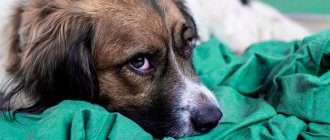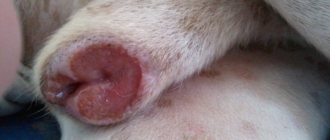Plague (Pestis) - a highly contagious viral disease characterized by fever, intoxication, damage to the skin and mucous membranes, respiratory and digestive organs in dogs. In some cases, it causes severe manifestations of meningitis and encephalitis.
Distemper has been known since the domestication of dogs. In the writings of Aristotle it is described as a sore throat. In Russia, it appeared in 1762 in Crimea and was called the “Crimean disease.” The viral nature of the plague was first proven in 1905 by the French scientist Carré (Carré disease).
Causes of plague
The dog became infected with distemper
The main reason is infection with a dangerous, highly contagious virus.
The causative agent of plague is an RNA virus from the paramyxovirus family (canine morbillivirus).
Properties of the virus
The properties of this virus include:
- The virus is not stable in the external environment. In nasal discharge and feces of sick animals, it loses activity after 7-11 days.
- Dried or frozen virus lasts for several months, and in a lyophilized state - for at least a year. Heating to 60°C destroys it in 30 minutes, to 100°C - instantly.
- Disinfectants and physical factors deactivate the virus quite quickly: 1% and a solution of Lysol and ultraviolet rays - in 30 minutes, 2% and a solution of caustic soda - 60 minutes, sunlight and 0.1-0.5% solutions of formalin and phenol - through few hours.
Animals most susceptible to infection
The disease in the form of an epizootic (epidemic in animals) occurs throughout the world. Silver-black foxes, arctic foxes, Ussuri raccoons, ferrets, sables, bears, weasels, stoats, and wolves are susceptible.
Maternal antibodies, detected in colostrum and milk, create passive immunity in puppies up to the age of 1.5-2 weeks, but not always. Those who have recovered from plague have long-lasting immunity, but it is not sterile and not necessarily lifelong.
Even immunized animals lose resistance to distemper as a result of prolonged stress, immunosuppression, or contact with an openly sick animal.
Which dogs are at risk?
More often, the generalized form occurs in unvaccinated dogs , especially in puppies 8-16 weeks of age with impaired colostral (obtained from the mother's colostrum) immunity.
Short-faced animals get sick less often than long-faced ones. Almost all dogs suffer from distemper in one form or another, but more often it occurs in puppyhood.
Is it transmitted to humans?
Many people may have a question: Is canine distemper transmitted to humans?
The answer is simple - a person cannot become infected with distemper, no matter what form the dog gets sick with. The plague causative virus is absolutely not dangerous to the human body, so you should only worry about the health of the animal and that it can infect other pets.
Where can you get infected? Sources of plague
Signs of plague
The source of infection is an infected animal
, which releases the virus into the external environment, the virus is contained in discharge from the eyes and nose, in exhaled air, saliva, feces and urine for 10-51 days.
Factors of transmission of the virus include contaminated animal care items, clothing, food, insects, birds and rodents. The latter are not only mechanical carriers, but also secrete the virus without showing signs of disease.
The reservoir of the virus pathogen in nature is wild animals and stray dogs. The disease occurs at any time of the year and manifests itself epizootically or sporadically.
How does the vaccine work?
After vaccination, the vaccine, which contains the antigen, develops artificially acquired immunity in the dogs’ bodies. It is due to it that increased protection against various pathologies of an infectious nature occurs.
In other words, the dog’s immunity independently identifies areas with weakened infectious agents and begins to secrete antibodies that subsequently neutralize the virus. When a dog encounters a pathogen, its immunity causes its complete destruction and also prevents the development of the disease.
The immunity obtained as a result of the administration of serum is called active.
Symptoms and signs of distemper in dogs
The incubation period (the moment the virus enters the body before the first signs of distemper appear) in a dog lasts 3-21 days or more, sometimes 60-90 days. With the development of animal immunity, the clinical picture of distemper has changed significantly in recent years.
Previously, distemper in dogs occurred in clinically pronounced forms with fever and intoxication, but recently atypical forms have been more often recorded or the disease occurs in conjunction with other infectious diseases.
In the early stages (3-5 days) the disease is characterized by:
- weakness and lethargy
- poor digestion
- bilateral (on both sides) serous, serous-purulent conjunctivitis;
- in the morning or during the day, the eyelashes are glued together with pus (white, gray or greenish), it is difficult to open the eyes;
- severe photophobia appears.
- dogs go into the shade, hide under a closet, bed or table, and strive for a cool place.
In parallel or later (after 3-5 days) the following develops:
- rhinothea (profuse nasal discharge);
- dry cough, which becomes wet after 5-7 days, especially with timely treatment;
- nasal discharge is clear, cloudy or greenish in color.
Forms of plague and course of the disease
Distemper in a dog
Depending on the severity of the clinical symptoms of plague, several types of plague are conventionally distinguished:
| Types of plague | ||
| Form | Symptoms | |
| Skin | The appearance of red spots with signs of inflamed skin, as well as ulcers and pus. The mildest form of distemper, but if proper treatment is not carried out in time, there is a high risk of death of the dog. | |
| Intestinal (gastrointestinal) | It manifests itself as serious damage to the digestive system, including acute gastroenteritis, and is accompanied by refusal to feed, vomiting, as well as constipation and diarrhea, which leads to dehydration and rapid exhaustion of the dog. Feces contain a lot of mucus, often mixed with blood. | |
| Pulmonary (respiratory) | It is characterized by severe damage to the respiratory system: first the upper and then the lower respiratory tract. In this case, rhinitis, tracheitis, bronchitis, pneumonia or their mixed forms (acute catarrh of the upper respiratory tract, tracheobronchitis, bronchopneumonia) consistently develop. | |
| Nervous | The most severe form of distemper in dogs . The prognosis is often unfavorable. Serious complications include meningitis, encephalitis, meningoencephalitis, myelitis, paresis and paralysis of the limbs and sphincters of internal organs, as well as epilepsy. They develop as a result of the introduction of a virus into the cells of the spinal cord, brain and its membranes. Symptoms appear 2-6 weeks after infection. In weakened and immunized dogs, these symptoms can occur suddenly, without prior development of symptoms of general intoxication, high fever, etc. | |
| Mixed (generalized) | The generalized form occurs in 90-95% of cases of dog disease. It includes clinical symptoms of cutaneous, pulmonary, intestinal and nervous forms. The division into these forms of plague is conditional. | |
The development of one form or another is largely determined by the reactivity of the dog’s body. The same strain of the pathogen causes different clinical signs, ranging from a temperature reaction to nervous symptoms.
Also, in addition to the severity of clinical symptoms, plague can be divided according to the speed and method of the disease. The following forms of the disease are distinguished:
- Lightning fast. With a lightning-fast course, there are no obvious signs of the disease, the death of the animal occurs within one day.
- Spicy. In acute cases, a sharp increase in body temperature to 39.5 - 41 ° C is noted, especially in the evenings or at night. Appetite is distorted, but most often decreases, and at high temperatures completely disappears. Thirst increases. A comatose state develops, in which the dog or puppy dies on the 27th day of the disease.
- Subacute. Characterized by high fever that lasts from one day to two weeks. Then the fever becomes mild. In puppies 1-1.5 months of age, the temperature rises slightly or remains within normal limits. Along with fever, sick dogs exhibit depression, lethargy, muscle tremors, fearfulness, loss of appetite, dryness and roughness of the nasal mucosa. In rare cases, hardening of the paw pads may occur.
- Chronic. Most often characteristic of cutaneous and nervous forms. At the same time, in recovered animals, convulsive twitching of individual muscle groups, cuts and paralysis, as well as blindness, deafness, loss of smell, scars on the cornea, overgrowth of the pupil or atrophy of the eyeball, epilepsy remain for a long time, often for life.
- Abortive form. With a benign course, the clinical symptoms of plague are practically erased and often go unnoticed.
A good example is that a dog has a nervous form of distemper.
Variants of the course of the disease
To date, 4 forms of distemper in dogs have been identified:
- lightning;
- apathetic;
- acute;
- chronic.
Each option has its own set of symptoms. Let's look at them to be savvy in any situation.
1. Lightning fast
This type of disease is perhaps the most elusive. Outwardly, the dog practically does not betray its condition. She can be active, playful, sociable. As a rule, with this course of the disease, only a refusal to eat is observed, but in most cases the owners do not have time to focus on this. Within a few days after infection, the animal dies. Sudden death is often attributed to cardiac arrest. The true cause can only be revealed through detailed research.
2. Apathetic
Another hidden form of plague. However, unlike the fulminant type, in this form the disease can last up to several months. For example, a dog may begin to limp, but this will go away within a day or two. Other symptoms appear and disappear, dulling the owner’s vigilance. As a result, the already advanced disease enters the lightning stage, and the animal suddenly dies.
3. Spicy
This is the so-called classic Carré disease. In this case, all the symptoms are visible and appear in combination. If the owner acts correctly, there is every chance of saving the pet.
4. Chronic
Unlike the apathetic form, all symptoms are present, but they are expressed implicitly. If you are attentive to your pet, you can detect the disease, but often the disease clearly manifests itself at the last stage and develops into an acute form.
Diagnosis of canine distemper
The diagnosis of distemper in an animal is made on the basis of epidemiological data, clinical signs, pathological changes and laboratory test results.
To make a diagnosis based on clinical signs, the veterinarian takes into account the following criteria::
- Damage to the respiratory organs;
- Catarrhal gastroenteritis (inflammation of the mucous membrane of the stomach and intestines)
- Catarrh of the mucous membranes of the eyes and nose with serous or purulent discharge;
- Hyperkeratosis of the paw pads, fingers, nose and entire skin with the formation of a large amount of dandruff;
- Damage to the central nervous system with convulsions, epilepsy, paresis, paralysis, meningitis and meningoencephalitis.
If any four or five of these signs are noticed in a dog, then they indicate the occurrence of distemper. Based on two of the listed signs, a disease can be suspected, and based on three, a clinical diagnosis can be made.
Preparing animals for vaccination
Only clinically healthy animals are allowed for preventive and therapeutic vaccinations. Before immunization, a veterinarian conducts a comprehensive examination. The dog's body temperature is measured and blood is taken for analysis. If there are no contraindications, the puppy or adult dog is completely healthy and is vaccinated.
Important! Animals are vaccinated before or only after the complete change of milk teeth.
If the dog is weakened, the pet is at the stage of recovery from infections, immunization is postponed to another time, that is, when the four-legged friend is completely healthy.
The dog must be vaccinated by a veterinarian in the clinic after a comprehensive examination.
Before vaccination, it is worth deworming the dog about two weeks in advance, using special anthelmintics in tablets, emulsions for puppies, adults, which can be purchased at a veterinary pharmacy, clinic, or pet store in your city.
At the same time, preventive and therapeutic deworming, dogs are treated against ectoparasites with insecto-acaricidal agents (Bars Forte, Dana, Advocate).
Treatment of distemper in dogs
Timely veterinary care is of great importance in the treatment of this disease. It must be comprehensive. If you suspect distemper in an animal, the right decision is to call a veterinarian at home.
Treatment against plague is carried out in several areas:
- Specific (serum, immunoglobulins),
- The use of immunostimulants and immunomodulators (immunofan, ribotan, fosprenil, etc.),
- Symptomatic: antibacterial drugs (to suppress secondary microflora),
- Cardiac, astringent drugs, vitamins, electrolytes (to relieve intoxication and dehydration), antihistamines,
- Anticonvulsants and substances that stimulate the activity of the central nervous system (Forvet, etc.)
The sick dog is placed in a separate, clean, warm, draft-free, well-insulated dark room (isolated room) with moderately humid air. Prescribe peace and quiet.
Antimicrobial drugs are widely used in complex treatment : antibiotics, sulfonamides, nitrofuran and quinoxaline derivatives. Antibiotics are used taking into account the sensitivity of the microflora to them. Carefully study contraindications for use.
In parallel with antimicrobial substances, vitamins and multivitamins are needed with food or separately. Vitamins required during recovery are ascorbic acid 2-3 times a day orally or parenterally (in the form of injections), B vitamins, which are administered subcutaneously or intramuscularly. The duration of the course of treatment is determined by the veterinarian.
To increase resistance, at the onset of the disease, it is recommended to administer polyvalent hyperimmune serum against plague subcutaneously 3 to 4 times with an interval of 12-24 hours. Injections should be done carefully, given the high allergenicity.
Safer, but no less effective, is the injection of gamma and immunoglobulin. In addition to globulins, sometimes in combination with them, interferon is prescribed parenterally or externally. The course and dose are determined by the attending veterinarian. Interferon is instilled into the nose and eyes, 1-2 drops 3-4 times a day, for a week or more.
Some veterinarians successfully use thymogen, thymalin, timoptin, gactivin, anandin, comedon and others strictly according to the instructions.
Symptomatic therapy for canine distemper is carried out depending on the symptoms of disruption of the activity of a particular internal organ or an entire system.
Nutrition during illness
Dietary food is prescribed. In this case, take into account the age and breed characteristics of the animal.
Dog treatment
First, a fasting regime is established for up to 12-24 hours with free access to water or rehydration solutions. In a bowl of boiled water, it is advisable to add a small amount of decoctions or infusions from medicinal plants (coil rhizome, marshmallow root, string, sage leaves, oak bark, oregano, cinquefoil erect, yarrow, chamomile, calamus rhizome, licorice, chaga, St. John's wort, blueberry fruits, bird cherry, horse sorrel, flaxseed, roots and rhizomes of burnet (officinalis).
These plants have medicinal effects on the body of a sick animal - enveloping, astringent, mucous and anti-inflammatory.
For 2-3 days, a small amount of liquid (water or broth) rice or oatmeal porridge, jelly or decoction is introduced into the diet, pre-mixed with a small amount of boiled chicken or ground beef (1-2 tablespoons per dose). If the dog does not develop indigestion in the form of vomiting and diarrhea after such a dacha, then the dose of food is gradually increased.
On days 4-5, fresh low-fat lactic acid products at room temperature are added to the specified diet: yogurt, kefir, acidophilus and acidophilus milk. It is advisable to use flaxseed decoction in the diet from the first days of treatment.
On days 7-9, boiled finely chopped vegetables are introduced into the diet - carrots, cabbage, potatoes.
From the 10th day, dogs are transferred to a normal diet.
If the patient is severely malnourished, artificial feeding through the rectum with nutritious and medicinal fluids is useful. As nutrient mixtures, 2-20% glucose solutions, 0.5-1% sodium chloride solutions, Ringer's and Ringer-Locke solutions, rice, oatmeal, flaxseed decoctions, meat, chicken or beef broth, peptone with saline solution are used ( 1:10), milk and combinations of these substances.
Before administering the medicinal nutritional mixture, the rectum is emptied of contents. To do this, they do a warm cleansing enema, which relieves pain and reduces muscle tone, which is important for retaining the nutritional or medicinal component introduced into the rectum.
An effective means of maintaining fluid balance is intravenous fluids. If it is not possible to install a drip system, the veterinarian prescribes subcutaneous injections. Subcutaneous injections of large volumes are conveniently made in the area of the shoulder blade or at the withers, preferably at several points 4-6 times a day, if necessary for several days in a row.
Treatment with folk remedies
Treatment with folk remedies can only be carried out as an addition to the main course of treatment and in the early stages in a mild form. You can also try folk remedies in the treatment of distemper if, for one reason or another, it is not possible to carry out treatment under the supervision of a veterinarian (for example, there are no veterinary clinics nearby).
One of the methods was described above - these are infusions from medicinal plants (serpentine rhizome, marshmallow root, sage leaves, oak bark, oregano, yarrow, chamomile, calamus rhizome, licorice, chaga, St. John's wort, blueberries, bird cherry, sorrel). Give 1-2 glasses per day. These infusions will help remove toxins and help with the functioning of the central nervous system.
Another very popular home treatment method is a mixture of vodka and egg yolk . Take a tablespoon of vodka and 1 yolk (you can add honey), mix thoroughly and give it to the dog 2-3 times a day for 3-4 days.
It is highly not recommended to use these treatment methods without consulting a veterinarian!
Proper nutrition
Another additional method of prevention is organizing proper nutrition. Your pet's body will need strength to resist the virus, so take care of a balanced diet.
Your pet can get the required amount of protein every day not only from meat, but also from cottage cheese. The daily requirement of dietary vitamins is contained in raw liver, and the dog can get the required amount of iron from semolina. Millet is a source of nicotinic acid, buckwheat is a source of lecithin, etc. In general, food should be varied.
Good advice: do not use only ready-made mixtures and especially dry food in your dog’s diet. Along with ready-made store-bought delicacies, the animal should also receive regular cereals and stews. Such food has a positive effect on digestion. Don't forget about water, especially if dry food is present in the diet.
Prevention and control measures
In Russia, for specific prevention, domestic vaccines are used:
- vakchum;
- EPM;
- KF-668;
- multican;
- trimevak and others.
Recently, effective and low-toxic monovalent and complex vaccines have been arriving from abroad:
- hexadogue (France);
- Vanguard (Belgium);
- kanvak (Czech Republic);
- nobivac (Holland);
- Kanlan (Canada) and others.
Puppies are vaccinated from 2-3 months of age 1-2 times a year, and after a year they are vaccinated annually. The vaccine and vaccination schedule are determined by a specific veterinarian. Sellers, owners, doctors and other categories of citizens are strictly prohibited from distemper vaccinations.
After vaccination, the puppy or dog should not be walked. Keep in quarantine for 10-14 days. Before vaccination, deworming of the animal is necessary.
During illness, disinfection must be carried out in the premises where the sick animal was located. In case of death, the room is thoroughly disinfected with a 2% sodium hydroxide solution or a clarified solution of bleach with 2% active chlorine, 3% Lysol emulsion, 2% chloramine solution or Virkon C (Slovenia), etc.
A set of measures is carried out in accordance with special instructions.
The materials are for educational purposes only and do not in any form serve as a basis for independently diagnosing and treating a dog.
If your dog gets sick with distemper, first of all, you need to consult a veterinarian.
Remember – any initiative on the part of the animal owner can cause irreparable harm to the dog’s health!
Have you ever encountered plague? Leave questions for the veterinarian in the comments.
Grafting Basics
Many infectious diseases in dogs are easier to prevent than to cure, so vaccination is important for them. And every new owner of a small husky should know about this.
Animals are vaccinated against the following diseases:
Before the vaccine, the veterinarian must examine the puppy, since the injection can only be given to healthy dogs. A week before vaccination, the dog needs to be wormed. The most commonly given medicine is called Pyrantel.
Read also
Dog castration: 5 reasons for and against
Castration is one of the most responsible ways to care for a dog. With the help of the procedure you will reduce aggression and anxiety associated with testosterone
How to avoid rabies in dogs? Symptoms and signs
Rabies is a very dangerous, fatal disease in dogs. The animal becomes infected with a virus that causes acute attacks and damages the nervous system
Ticks in dogs: prevention and treatment
Spring, veterinarians warn, is the beginning of the season for the incidence of piroplasmosis, a deadly disease for dogs.
Fleas on a dog. How to withdraw?
Fleas can cause a lot of discomfort and suffering to your animals, but they must be removed very carefully
Ear mites in dogs: Symptoms and treatment of otodectosis
Otodectosis or ear scabies is a chronic invasive disease caused by microscopic itch mites.
Laika vaccination schedule
Before the dog is one year old, it should receive several vaccinations. They are fully displayed in the table below.
| Age indicator | Disease | Note |
| 8 to 12 weeks | Parvovirus enteritis, leptospirosis, canine distemper, infectious hepatitis | The first vaccine is being made |
| 11-15 weeks | Parvovirus enteritis, leptospirosis, canine distemper, infectious hepatitis | Revaccination |
| 11–15 weeks | Rabies | Primary immunization. If the puppy was kept in greenhouse conditions, it is advisable to postpone vaccination until the teeth change. |
| From 9 months to 1 year | Parvovirus enteritis | This is the puppy's last vaccine, the next one is given a year later. |
| 9–12 months | Rabies | The last childhood vaccination, the next one is carried out a year later. |
It is worth considering that the data in the table is conditional; it may vary depending on the place and living conditions, the puppy’s health condition and viral diseases present in a certain region.
To whom is the virus transmitted?
Can the infection be transmitted to another dog? Veterinarians give a positive answer to this. This viral infection has the ability to be transmitted by airborne droplets. Therefore, it is enough for a dog to breathe on another pet to infect it.
At the first symptoms of the disease, the owner can begin a course of treatment for the dog. The infection is not transmitted to humans. The first priority in treatment is keeping the house clean. If there is an unvaccinated pet in the room, the floor covering should be regularly treated with disinfectants.
What drugs are used: prices
Modern vaccination preparations are divided into single vaccines and complex products. Their difference lies in the possibility of developing immunity from one disease or several diseases at once.
Typically, complex vaccines are used that protect against distemper and other canine infections. The most common among them are:
- Nobivak is divided into mono and complex types. Country of origin: the Netherlands. The cost of the drug will depend on the complex of diseases indicated on the medicine; it varies from 100 to 800 rubles.
- Multikan - this serum with complex effects is made in Russia. It is divided into three areas depending on the disease. The drug is highly effective and has positive reviews. Price ranges from 200-600 rubles.
- Vanguard - the vaccine was produced in the USA. It contains various vaccines except for rabies, so this vaccination will have to be done separately. On average in Russia, the cost of the product will be in the range of 300-500 rubles.
- Biocan - according to customer reviews, the drug is less effective than the first three. It was made in the Czech Republic. The cost in pharmacies is 300-600 rubles.
When is the first vaccination given?
As a rule, the first vaccination for a husky puppy is done in the kennel. This usually occurs at the age of 1.5 months. A veterinary passport is issued for the baby, which indicates: the date of vaccination, why it was given and the name of the vaccine. Therefore, before buying a puppy, it is important to study not only its pedigree, but also veterinary documentation.
If for some reason vaccination was not carried out (for example, a husky puppy got sick), taking care of this will fall on the shoulders of the new owner. In this case, you should consult a veterinarian so that he can examine the patient and create an individual vaccination schedule for him.
How your pet feels after vaccination
It is important to monitor the condition of your little husky after vaccination. As a rule, native breeds tolerate vaccinations well. However, no one is immune from negative reactions of the body.
In 5% of dogs, a slight swelling may form at the injection site. It does not require therapeutic intervention. But if it grows, swells, or does not go away within three weeks, you need to take your puppy to the vet.
Sometimes a pet may have an allergic reaction to the drug, including anaphylactic shock. But this happens extremely rarely. In addition, this side effect develops 5–15 minutes after the injection. Therefore, experienced veterinarians stay with the puppy for the specified time and monitor its condition in order to provide first aid, if necessary.
Within 24 hours after vaccination, a husky puppy may experience the following conditions:
- temperature rise to 39 ºС;
- refusal of food;
- vomiting, diarrhea (one-time);
- lethargy.
This reaction is considered completely normal and does not require veterinary intervention. At this time, it is important to provide your pet with peace. But if the described conditions do not go away after 24 hours, you need to show your pet to a doctor.











